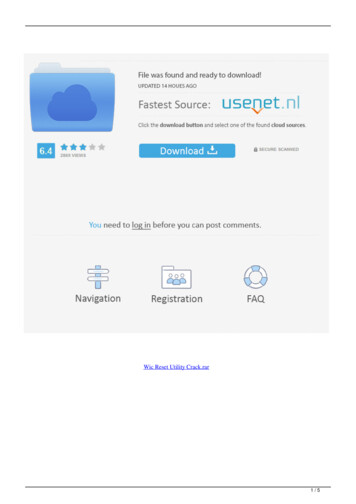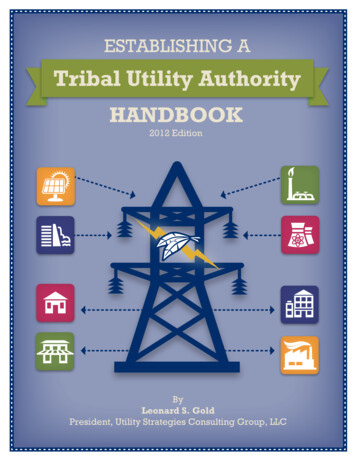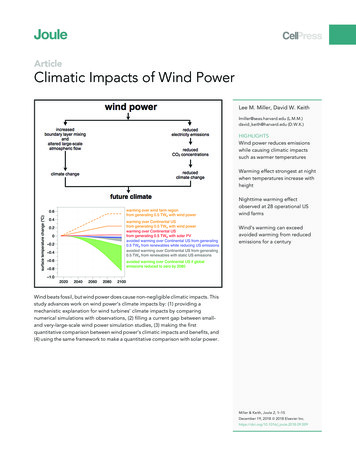
Transcription
Policy Research Project (PRP), LBJ School of Public Affairs,The University of Texas at Austin, May 2018.Project Director:Dr. Varun RaiAn Exploration of Property-Value Impacts Near Utility-Scale SolarInstallationsLeila Al-Hamoodah, Kavita Koppa, Eugenie Schieve, D. Cale Reeves, Ben Hoen, Joachim Seeland Varun RaiAbstractNationwide, electric utilities increasingly rely on solar installations as part of their energyportfolio. This trend begs the question of how they affect nearby home values. Understandingwhether these installations are amenities or disamenities and the scale thereof will helppolicymakers, solar developers, and local utilities to site and build solar installations withminimal disruption to nearby communities. This paper investigates where large solarinstallations are located, the housing and income characteristics of the surrounding areas, and ifthe installations affect nearby residential property values. We approach these questions usinggeospatial analysis and a survey of residential property assessors. Geospatial analysisexamines both housing density and median income surrounding these facilities, while thesurvey gauges local assessors’ opinions of the impacts of these installations on property values.Property values can be a useful proxy for various non-market goods like scenic value, taxbenefits, and of particular interest here, both positive and negative perceptions of utility-scalesolar facilities. Our results show that while a majority of survey respondents estimated a valueimpact of zero, some estimated a negative impact associated with close distances between thehome and the facility, and larger facility size. Regardless of these perceptions, geospatialanalysis shows that relatively few homes are likely to be impacted. Though only one componentof a larger analysis, these property value impacts are likely to be of growing interest as moresolar facilities are built. This exploration of impacts will help inform solar developers, publicofficials, home assessors, and homeowners about the effects and implications of solar energyinfrastructure.IntroductionThe installation of utility-scale solar facilities continues at a rapid pace across the United States,with over ten gigawatts of new photovoltaic (PV) capacity installed in 2016 alone (Bollinger etal., 2017: p. 1; Perea et al., 2016). These utility-scale PV installations, often informally calledsolar farms (Fehrenbacher, 2016; New York State PV Trainers Network, 2017), are defined hereto include installations one megawatt (MWAC) and larger. Like other power plants, these utilityscale solar installations have the potential to impact nearby home values. The potential adverseimpact on home prices due to the installation of solar utilities is relevant to solar developers,public officials, home appraisers, and homeowners, yet no peer-reviewed literature has directlyaddressed the subject to date.The primary research question is: Do utility-scale solar PV installations impact the value ofnearby homes? This study contributes to the existing literature on amenities and disamenities1
Policy Research Project (PRP), LBJ School of Public Affairs,The University of Texas at Austin, May 2018.Project Director:Dr. Varun Raiby extending the research to utility-scale solar PV installations. Amenities are considered to befeatures that increase the value of a home, while disamenities have the opposite effect. Theinformation in this study tackles relevant issues for solar stakeholders and identifies questionsfor future research.Background and Literature ReviewResidential housing literature covers a broad range of amenities and disamenities, includingopen-space and water views (Anderson & West, 2006; Bond et al., 2002), as well as landfills,coal-fired power plants, shale gas production facilities, oil and sour gas facilities, andtransmission lines (Anderson et al., 2007; Des Rosiers, 2002; Case et al., 2006; Muehlenbachset al., 2014; Davis, 2008; Locke, 2012), respectively. Research on High Voltage TransmissionLines (HVTLs), for example, has found adverse effects on proximate home values to be presentin some analyses, while not in others, and, in general to be sensitive to micro-siting differences(Anderson et al., 2007; Des Rosiers, 2002). Alternatively, research on power plants and naturalgas facilities has found that increasing proximity to the disamenity correlates to a greaterchange in property values (Davis, 2008; Boxall, 2005).In the case of utility-scale wind turbines, much of the available research in the U.S. has notfound consistent or compelling evidence of sales price impacts on homes (Hoen et al., 2015;Hoen & Atkinson-Palombo, 2016; Lang & Opaluch, 2013). In fact some studies havedocumented wind turbines’ connection to increased property tax revenues to local schooldistricts (and local taxing entities), which might be connected to increased property values byextension (Loomis & Aldeman, 2011). Additional benefits of utility-scale wind can include jobgrowth, supply industry growth, landowner profits, and road improvement, most of which are aneffect of increased tax revenue from the large installations (Loomis et al., 2016). Recent surveyresults suggest that U.S. residents living near wind facilities prefer living next to a wind turbineover more conventional energy infrastructure, such as coal, nuclear and natural gas (Hoen etal., 2018). Respondents in the same survey who lived within a half a mile of a wind projectexpressed similar preferences between living next to a wind (37 percent) or a solar facility (24percent), with roughly a third having no opinion, but these differences were not statisticallysignificant. This, therefore, suggests that disamenity research on wind’s effects on propertyvalues, a proxy for local preferences, might provide a reasonable basis for comparison to utilityscale solar facilities.To the best of the authors’ knowledge, no existing peer-reviewed research provides quantitativeevidence of property value impacts associated with utility-scale solar facilities, but existingstudies address related areas. Previous research on residential PV installations, for example,has indicated that buyers place a premium on homes with PV systems (Hoen et al., 2017). Inaddition, available literature has explored public opinions surrounding utility-scale solarinstallations and perceived property value impacts. A survey by Carlisle et al. found that around80 percent of U.S. survey respondents support the development of large-scale solar facilitiesboth in the U.S. generally, and within their own county (2015). However, this survey also2
Policy Research Project (PRP), LBJ School of Public Affairs,The University of Texas at Austin, May 2018.Project Director:Dr. Varun Raiindicated that 70 percent of respondents believe these installations will decrease propertyvalues. A public opinion survey on solar facilities by the Idaho National Laboratory found that 43percent of respondents in the southwest United States believed that a view of a large-scalesolar facility would decrease the value of their home, while 23 percent believed it would increasethe value (Idaho National Laboratory, 2013). In the same survey, one fifth of respondentsindicated that a buffer of less than a mile would be acceptable between utility-scale solarfacilities and residential areas (21 percent), while the remainder believed the buffer should bebetween one and five miles (26 percent), six and ten miles (16 percent), more than ten miles (21percent), or were unsure or had no preference (16 percent). Notably, respondents in thesouthwest sample were more open to proximity to solar installations within one mile of aresidential area (26 percent) than was the national sample. Finally, select appraiser researchconducted in North Carolina has found that utility-scale solar facilities have no impact onproperty values (Kirkland, 2006).In addition to the above research, various media outlets provide evidence of a perceived impacton home prices by homeowners. News articles from California, North Carolina, and Tennessee,for example, identify communities that expressed displeasure over solar installations proposedor constructed near their homes (Lunetta, 2017; McShane, 2014; West, 2015). Online forumsalso indicate concern by homeowners about the potential impact of a solar farm on home values(Zillow, 2017; Realtor.com, 2011; HackettstownLiFE, 2011). Some common concerns overproximity to solar farms include changes in property values due to the solar installation’sappearance, safety or health concerns, or changes in the environment, such as water run-off ordisplaced wildlife (McShane, 2014; HackettstownLiFE, 2011; West, 2015; Appraisers Forum,2015). Other homeowners expressed no concern about living near a solar facility, or evenpreferred solar farms to alternative uses like animal agriculture, wind farms, industrial uses, orhousing development (Zillow, 2017; HackettstownLiFE, 2011). Online forums also indicate thatappraisers have varying opinions about whether solar installations may constitute a disamenity(Appraisers Forum, 2015).Building upon the available amenity, disamenity, and public opinion literature, this studyexplores the impact of utility-scale solar installations on home values using two complementaryanalytical approaches: a geospatial solar-siting analysis and a survey of property assessors.First, the solar-siting analysis examines both housing density and median income surroundingthese solar facilities. This will provide context on the scope of potential impacts due to proximityto solar, by identifying the number of homes that may be affected and the characteristics ofthose residents. Next, a survey of residential property assessors was conducted to evaluate thescale and direction of those impacts, if any. This research seeks to understand both thecharacteristics of utility-scale solar installations as they relate to neighboring homes, and anypotential impact on home prices due to proximity to a solar installation. The remainder of thepaper outlines the data, methodology, and results of each analytical approach. It then identifieslimitations and suggestions for further research, and concludes with recommendations forpolicymakers and other stakeholders.3
Policy Research Project (PRP), LBJ School of Public Affairs,The University of Texas at Austin, May 2018.Project Director:Dr. Varun RaiSolar-Siting AnalysisThe solar-siting analysis assesses the scope and equity distribution of utility-scale solar’spotential impact on nearby property values. It does so by considering the number of homes thatmay be affected by proximity to solar. To do this, we mapped the locations for utility-scale solarfacilities in ArcGIS 10.5, and combined it with housing census and median income data. Themedian income data was compared to the national average to determine if the siting of utilityscale solar raises any equity concerns.DataThe primary data for this analysis is 956 unique solar sites completed in 2016 or earlier withconfirmed latitude and longitude coordinates. This list was developed using data from the U.S.Energy Information Administration’s (EIA) Form 860 and proprietary data from LawrenceBerkeley National Lab (LBNL), containing a total of 1,805 solar installations. Many utility-scalesolar sites were included in both datasets, but sometimes differed in coordinates or totalcapacity due to aggregation. To ensure the accuracy of the latitude and longitude coordinatesfor these sites, the research team reviewed satellite images of each site. Installations wereexcluded if the provided coordinates were not directly on top of solar panels in satellite imagery.Where the EIA and LBNL sources reported different coordinates, the coordinates that moreaccurately aligned with the center of the array were used. Finally, entries in the EIA’s databasewith a shared plant code ID were combined into a single facility with their summed nameplatecapacity.Ultimately we used 956 out of 1,805 installations that had been cleaned and compiled from theEIA and LBNL sources in this mapping analysis. In general, this sample of facilities used in theanalysis has a similar distribution of nameplate capacity to the 1,805 installation sites. Theaverage nameplate capacity of the full sample (1,805 installations) and the selection used in ouranalysis (956 installations) were not statistically significantly different (p-value 0.5). For acomplete comparison of the analyzed and total solar installation descriptive statistics, seeAppendix C.1. The location of the facilities is also similarly distributed, with California hostingthe most facilities, followed by North Carolina, in both sets. Thus, these 956 sites arerepresentative of the total 1,805 installations from the EIA and LBNL sources. Figures C.2 andC.3 in the appendix present histograms of total nameplate capacity for the two groups. Theminimum, median, average, and maximum capacity of these 956 installations is 0.4MWAC,4MWAC, 12MWAC, and 314MWAC, respectively.1 These installations were then broken intocategories based on capacity: 1-4.99MW, 5-9.99MW, 10-19.99MW, 20-49.99MW, 50-99.99MW,and 100 MW.1While we define utility-scale solar as facilities 1MW and higher, three sites under 1MW were included inthe underlying EIA database. These were included in our dataset as well.4
Policy Research Project (PRP), LBJ School of Public Affairs,The University of Texas at Austin, May 2018.Project Director:Dr. Varun RaiThese GIS data are merged with data on housing density and median household incomeestimates throughout the United States. We used data on housing population density andmedian household income from the American Community Survey’s 5-Year estimates ofunweighted sample housing units and median household income by census block group. Wejoined estimated housing units and median household income per block group to TIGER/LineShapefiles provided by the U.S. Census Bureau and displayed them as a density across theUnited States.MethodologyTo begin this analysis, the latitude and longitude coordinates for the verified operating solarfacilities were plotted in ArcGIS. Starting from the coordinates of the solar facility, radii of 100feet up to three miles were used to create select areas, or buffers, around the solar facilities. Toaccount for the area of the solar facility itself, where no home could possibly exist, a circulararea originating from the center of the facility was created, which we call here a “pseudopolygon” (See Figure A.1). These pseudo-polygons were calculated by estimating the averagearea of utility-scale solar installations (the team assumed an average of 6 acres/MW), and thencalculating the radius needed to equal the estimated area required. Pseudo-polygons werecreated for the following categories: 1MW 1-4.99MW (6 acre circle); 5MW 5-9.99MW (30acres), 10MW 10-19.99MW (60 acres); 20MW 20-49.99MW (120 acres); 50MW 5099.99MW (300 acres); and 100MW 100MW (600 acres) facilities. For the complete pseudopolygon calculations, see Appendix C.4. Outside the pseudo-polygon, buffer zones of 100 feet,500 feet, 1,000 feet, one half mile, one mile, and three miles were then used to estimatedistances from the facilities. For a full extent of the buffer zones, see Appendix C.5. Estimatesof the number of homes that exist within each zone were calculated, using the proportion of theblock groups which overlapped with the distance radii. The number of homes within eachdistance radii were summed, by combining the buffer zones with aggregate housing data blockgroup polygons. In some cases, those polygons did not fall completely within the buffer zones.In that case, housing units were estimated by comparing the area of the block group to the areaintersecting the buffer zone, and proportioning the total housing units for the block groupaccordingly.5
Policy Research Project (PRP), LBJ School of Public Affairs,The University of Texas at Austin, May 2018.Project Director:Dr. Varun RaiFigure A.1: A satellite image of a pseudo-polygon (white) and the buffers (yellow) beginning at 100ft out to½ mile are shown above. The pseudo-polygon buffers the area of the facility to account for the area whereno homes can exist. As presented above, the pseudo-polygon does not encompass the entire facility,making the polygons a conservative estimate of the true facility size.The next analysis with ArcGIS sought to compare the median household income of residentsliving near utility-scale solar installations to that of the national average. Given the rapid growthof utility-scale solar within the past decade, the income of residents living nearby utility-scalesolar utilities serves as an important indicator of equity in the siting of those facilities. This maybe due, in part, to lower land prices. If solar were to be determined a disamenity,disproportionate build-out of utility-scale solar in lower-income communities could raiseconcerns about equity. In contrast, if proximity to solar is found to be an amenity, presence nearlower income communities could increase home values. To determine whether or not utility6
Policy Research Project (PRP), LBJ School of Public Affairs,The University of Texas at Austin, May 2018.Project Director:Dr. Varun Raiscale solar is located in communities which earn less than the national median income, wecompared 2015 median income figures by block group within three miles of utility-scale solarinstallations to the national median income in the same year.As above, 2015 U.S. median household income by block group data from the IPUMS NHGISDatabase was joined with 2015 Block Group TIGER/Line shapefiles in ArcGIS. Of the medianincome data, approximately 6,484 of the 217,203 block groups (about 3 percent) did not reportmedian incomes. As with housing density, most distance radii capture multiple block groups withdiffering reported median incomes. To estimate the median income at every distance, eachdistance radius was broken down by its percent of block groups. The median income of eachweighted block group was then totaled to find a unique median income for every distanceradius. In ArcGIS, this was accomplished using the same installation data and pseudo-polygonsas above, and by intersecting these datasets with block group median income. A weighted sumof median income surrounding each facility at every buffer distance was calculated bydetermining the area of the block group intersected in proportion to the rest of the buffer area.The proportion of the block group area was then multiplied by its median income. Finally, themedian income for the total area of the buffer was summed using the facility ID.ResultsOur analysis indicates that the greatest total number of estimated homes in proximity to solarinstallations is within three miles (cumulatively) of 1MW facilities (534,725 homes), while thesmallest number of estimated homes is within 100 feet of 100MW facilities (ten homes). Heatmaps of housing population with utility-scale solar installation locations both nationwide andCalifornia alone are presented in Appendices C.6 and C.7. An estimate of the total number ofhomes within three miles of the 956 solar facilities used in our analysis is presented in TableA.1 (for an extrapolation of the total number of homes within three miles of all 1,805 facilities,see Appendix C.7). These findings are consistent with the authors’ expectations that morehomes will be located near smaller facilities, where areas of higher population densities can onlypermit small facilities, and accordingly that the largest facilities will be located in rural regions.Not surprisingly, the total number of homes increases as distance from the facility, and thereforeland area, increases. Further, an estimate of the average number of homes residing within thevarious distance radii of the capacity range of solar facilities is shown in Table A.2. Thesefindings show similar trends: more homes will be found further from facilities and near smallerfacilities. An average of 22 homes are located within three miles of a 1MW facility, while lessthan one home will be located within 100 feet of a 100MW facility, on average. Finally, a stackedbar of new utility-scale solar installations by year online and capacity size is presented in ChartA.1. This suggests that while the total number of all facilities is rapidly increasing, the largestfacilities, 50MW and 100MW appear to be increasing the most rapidly.7
Policy Research Project (PRP), LBJ School of Public Affairs,The University of Texas at Austin, May 2018.Project Director:Dr. Varun RaiTable A.1: The table below provides a count of the total number of homes in the U.S. located within certain distancesof utility-scale solar. As indicated below, housing estimates increase as the utility-scale solar installations decreasesin MW capacity and distance from the facility increases.Table A.2: The table below provides a count of the average number of homes within a certain distances of individualutility-scale solar installations. The actual number of homes will vary by facility, but this table may serve as a usefultool for estimating the number of homes impacted by utility-scale solar8
Policy Research Project (PRP), LBJ School of Public Affairs,The University of Texas at Austin, May 2018.Project Director:Dr. Varun RaiChart A.1: The chart below provides a count of utility-scale solar shown by capacity and year online, shown as apercentage. While 1MW are steadily increasing, larger utility-scale solar installations appear to be gainingprominence.These housing density estimates inform the survey analysis discussed below by estimating themagnitude of property value impacts, if present. These total housing estimates are conservativeas they only consider the 956 confirmed utility-scale solar sites, rather than all known solar sitesin the United States. While an extrapolation is made in the appendix (C.8), the estimates areless certain. Further analysis should be expanded to all utility-scale solar sites in the U.S. withcorrected coordinates, and continued analysis that stretches beyond 2015-2016 will be criticalgiven the rapid growth of utility-scale solar. In regards to the average housing density estimates,they follow the trend that fewer homes will be expected at increasing facility sizes anddecreasing distance from a facility. This housing data can be used to estimate the number of9
Policy Research Project (PRP), LBJ School of Public Affairs,The University of Texas at Austin, May 2018.Project Director:Dr. Varun Raitransactions that occur within these buffer zones. Transaction estimates can be adjusted basedon region and current market trends.This analysis also considered median household incomes surrounding solar installations. Theestimates of 2015 median income by block group is displayed below as a box plot with ahorizontal line indicating the national median household income for that year ( 56,515) (SeeChart A.2). The highest median income was located within three miles of 1MW facilities( 59,579), while the lowest median income was located within one mile of 50MW facilities( 34,223). Most notable were the consistencies of the median income near 1MW facilities withthat of the national average; and that the interquartile ranges for 100MW facilities are lower thanthe interquartile ranges of 50MW facilities, at all distances. These findings highlight that largerfacilities tend to be sited in areas with lower incomes. However, because only 27 100MWfacilities were included in this analysis – in contrast to the 521 1MW facilities – the fewerobservations will make the median income reported near the 27 100MW facilities more impactfulto the analysis. Overall, less variability in median income of nearby residents was observed withincreasing distance from a facility. Residents living within 100 feet to three miles of a 1MWutility-scale solar facility maintained relatively similar incomes ranging from approximately 57,000 to 59,000.While not definitive, these findings raise preliminary concerns regarding equity in the locating ofutility-scale solar. Our analyses suggest that the largest utility-scale solar facilities are mostlikely to be located in areas where residents earn lower incomes than the national average. Thisis consistent with the expectation that the largest facilities would require hundreds of acres ofland, which will more likely be located in rural areas. Issues with unreported median incomes bysome block groups influenced the calculations performed. An estimated median income of 58.89 within one mile of a 50MW facility was calculated here, but is unlikely. These lowestimates are the result of unreported median income data in some block groups. While the nullvalues were not included in the analysis, the values nevertheless affected the weighted sumcalculations. Despite unreported median incomes, examination of the interquartile rangesprovide valuable insight on the economic status of residents living near utility-scale solar. Withthe rapid expansion of utility-scale solar, our research suggests that property value impacts,whether positive, neutral or negative, could disproportionately affect homeowner’s with lowerincomes.10
Policy Research Project (PRP), LBJ School of Public Affairs,The University of Texas at Austin, May 2018.Project Director:Dr. Varun RaiChart A.2: These box plots display reported median income of all residents living within one mile of utility-scale solarinstallations. The horizontal line displays the national median income. In general the interquartile ranges of reportedmedian income appear to decline as installation size increases. Extreme minimums are the result of unreportedincome by block groups, as noted above. For a complete overview of median income, see Appendix C.Survey of Home AssessorsDataIn addition to evaluating the scope of potential property value impacts, this research sought toquantify the scale and direction of those impacts. We distributed an online survey to publicsector property assessors in 430 unique counties identified by the EIA Form 860 data as havingat least one utility-scale solar PV installation. The aim of this survey was to collect opinions as tothe effects of utility-scale solar PV installations on property values. Survey questions sought toevaluate, a) whether assessors believe there is an impact on home prices from utility-scale solarinstallations, b) the scale and direction of those impacts, and c) the sources of those impacts.Assessors, appraisers and real estate agents were all considered as possible targets for thissurvey research. We ultimately selected assessors, or appraisers hired by the public sector(herein referred to jointly as “assessors”), because of their work as public servants responsiblefor providing assessments of property values, in accordance with professional standards.11
Policy Research Project (PRP), LBJ School of Public Affairs,The University of Texas at Austin, May 2018.Project Director:Dr. Varun RaiThe survey asked respondents to provide several control variables, including their state andcounty, years of professional experience, and whether their manual provides instructionsregarding utility-scale solar PV installations. They were also asked to provide their opinion ofsolar energy in the United States, using a 7-point Likert scale. For a full copy of the survey, seeAppendix D.1.To address our research questions regarding possible property value impacts, respondentswere asked to estimate the impact on residential property values of three sizes of solar PVinstallations – 1.5MW, 20MW and 102MW – at distances ranging from 100 feet to three milesfrom the nearest home. These questions took the form of sliders with a range of negative 50percent to positive 50 percent. A satellite image indicating the approximate size of eachinstallation was also provided as a visual aid. In preparing these questions, we hoped to captureactual adjustments made by assessors in their professional practice, but allowed for perceptionsof potential impacts for those assessors that have not made such adjustments. Additionally, therespondents were asked to indicate on a 5-point Likert scale whether various features of solarinstallations, such as their size, height, and presence of a fence or other visual barriers, wouldhave a positive or negative impact on property values.This survey was determined by the University of Texas at Austin IRB to be exempt from review.2The survey was distributed via email to approximately 400 email addresses obtained via publiclyavailable websites. In addition, 53 counties with high numbers of installations, high total PVsolar capacity, and/or older installations were identified as high priority survey targets, and wereselected for phone follow-up to request their county’s participation. Phone follow-ups occurredover two weeks and not all counties were reached. This follow-up procedure motivated anadditional eight responses.2IRB Study Number 2017-12-0067 was determined to be exempt for the qualifying period 03/20/2018 to03/19/2021.12
Policy Research Project (PRP), LBJ School of Public Affairs,The University of Texas at Austin, May 2018.Project Director:Dr. Varun RaiSurvey ResultsOf the approximately 400 assessors contacted via email, 37 consented to participate in thesurvey (a 10 percent response rate, approximately). Survey respondents were geographicallydispersed across the United States, and represented 23 states of the 42 known to have utilityscale solar facilities, according to the EIA Form 860. North Carolina provided the mostrespondents (8), followed by Florida (3), Massachusetts (2), Connecticut (2) and Utah (2). Allother states represented had one respondent. Notably, no responses were recorded fromCalifornia, despite efforts to contact 13 California counties by phone. Below, Figure B.1provides a map of responses by state. For a more detailed breakdown of
2015). Other homeowners expressed no concern about living near a solar facility, or even preferred solar farms to alternative uses like animal agriculture, wind farms, industrial uses, or housing development (Zillow, 2017; HackettstownLiFE, 2011). Online forums also indicate that










